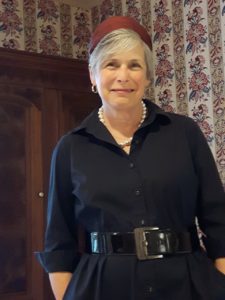Words from the Rabbi’s Desk
 It is so good to be home. My ordination weekend was spectacularly wonderful, emotionally moving and filled with moments I will remember to the end of my days. And I was so happy to be back at Kolot Mayim on Shabbat morning. We celebrated with Deena Kinarthy, and her family, Elior, Leah, and Ari, here in Victoria and beyond, and with Rowan Townshend and his parents and brother, Susan, Roger, and Isaac, from that other island – PEI. Then yesterday I was able to officiate at their wedding. I have celebrated a number of weddings by now, but this time was the first time as a Rabbi. Joy builds more joy.
It is so good to be home. My ordination weekend was spectacularly wonderful, emotionally moving and filled with moments I will remember to the end of my days. And I was so happy to be back at Kolot Mayim on Shabbat morning. We celebrated with Deena Kinarthy, and her family, Elior, Leah, and Ari, here in Victoria and beyond, and with Rowan Townshend and his parents and brother, Susan, Roger, and Isaac, from that other island – PEI. Then yesterday I was able to officiate at their wedding. I have celebrated a number of weddings by now, but this time was the first time as a Rabbi. Joy builds more joy.
Last week we read Shelach Lecha, and we learned about the leaders of the tribes who returned from their mission to investigate the Land of Canaan. Moses gave clear instructions. “How is it? And the people that dwells in it – is it few or numerous? …And how is the land? Is it fertile or is it lean? Are there trees in or not? You shall strengthen yourselves and take from the fruit of the Land. The days were the season of the first ripe grapes.” And yet, even though these leaders came back with reports – and proof of great abundance – they encouraged the people to not enter the Land. Doubt and fear overcame them. Only Joshua and Caleb said, “We can do this!” How many of us have turned away from abundance, from promise, because we felt fearful and undeserving? Shelach teaches us to welcome challenges, and in doing us find abundance – and then to always share that abundance, whatever it may be, as a gift from God.
This week in Korach we see this story refracted from another angle. Korach stepped forward and challenged not just Aaron but also Moses. “It is too much for you! For the entire assembly – all of them – are holy, and God is among them; why do you exalt yourselves over the congregation of God?” As we read these words, we may have sympathy for Korach – we too may ask, are we not all equal? Are we not all imbued with holiness? Are we not as a group – Israel – named holy in our relationship with God? Yet our tradition teaches us Korach, and his allies, were causing a deep rift amongst the people Israel. These words were dividing the people against themselves, and, ultimately, against heaven, against God.
While Korach comes to a most untimely end, I think we can all step back from this text and ask ourselves how we see ourselves within the people Israel. Are we helping to build? Are we working together?
Think of those two structures we have in our tradition: a sukkah to celebrate our autumn harvest, and a chuppah to celebrate a new home and a new family. Both are both symbols of a bayit, a home, and in doing so remind us that our homes, and ultimately our lives are fragile – and temporary. If we are truly to taste the abundance of life – to say yes to the blessings around us, then we also need to remember that the other side of abundance is fragility. Mishnah teaches: “Controversy for the sake of heaven will come to fruition, while that which is not for the sake of heaven will not. Controversy for the sake of heaven: that of Hillel and Shammai. Controversy not for the sake of heaven: that of Korach.
Let’s continue to work together over this coming year, and continue to build Kolot Mayim with open walls and an abundance of welcome.
Shavua tov and Shabbat shalom – a circle of peace.
Rabbi Lynn


Chukkat
July 9, 2019 by Rabbi Lynn Greenhough • From the Rabbi's Desk Tags: chukkat, red heifer, shabbat is in the bag •
Shabbat shalom everyone. I will be in Vancouver over the weekend officiating at the wedding of Ben Rolph, son of Wendy and Glenn Rolph Ben will be marrying his beloved Anna Klenin. We wish them and their families mazal tov.
Chukkat, our Torah reading for this week, is one of the strangest sections in Torah. With shades of magical realism we encounter the פָרָה אֲדֻמָּה the parah aduma, the Red Heifer, and the נְחַשׁ נְחשֶׁת, the Copper Serpent coiled around the staff of Moses. It is always interesting to ponder both the original intentions (speculation) of these origin stories, and consider how they carry meaning forward from nascent Biblical Judaism through Temple/Israel Judaism through Exile and Rabbinic Judaism to our own Modern era. We have had many phases as a people and as a religious tradition. As we read these origin stories year after year, we hope to glean from their primal telling, a glint of application into our lives today.
The Red Heifer was a cow brought to the Kohanim, the priests, to be a sacrifice; its ashes were then used for the ritual purification of Tum’at HaMet (the impurity of the dead), to purify any Israelite who had come into contact with a corpse. The Heifer had to be perfectly red – every hair on its body red as the ground, adamah, as the first human, adam. This purity, of course, proved to be elusive, even death continued to be a source of tumah, of ritual impurity. We thus evolved other rituals involving the elements of water and earth to achieve states of ritual purity.
Similarly, the copper serpent that we read about later in Chukkat, incorporates in the Hebrew, an alliterative bonding, (נְחַשׁ נְחשֶׁת), even as the serpent is coiled around the staff. The Israelites were threatened by plague of serpents in the wilderness, after complaining yet again about their conditions in the Wilderness. Many died, and their only safety was for them to look at the copper serpent, in a homeopathic like-to-likeness cure.
These readings remind us in many ways that the wisdom of our Torah is literally grounded in connection of people and Land. Ritual purity and impurity calls to mind the theories of Mary Douglas, and her writings about cultures and dirt. In her book Purity and Danger, Douglas attempted to explain the cultural nature of taboos around what was considered unclean – or polluted (dirt). If death is a source of ritual impurity then there must be a cultural response, a mechanism for regaining ritual purity.
When the people Israel were confronted with death from the plague of serpents, they needed a mechanism of regaining control – and survival. By gazing into what was now a copper symbol of potential death, they lived.
Every day we awake and thank God for returning our soul. Sleep is understood to be like a mini-death, and to awaken is to live. And consider that whilst modern medicine has evolved over the centuries the symbol for medical doctors is this:
On July 19th our last Friday night service until September, Kolot Mayim will host a “Shabbat is in the Bag” dinner. Please RSVP, so we have a sense of how many members will join us for a traditional and fun Friday night dinner. We will begin at 6 pm, with Gary Cohen arriving for Kabbalat Shabbat at 7:30. The idea is for each family to bring their “dinner” in a container, as well as the utensils, plates, etc. you will need. When done, we will just pack up our bags to take home. No one needs to cook for 40 – and cleanup is easy. What could be better!! I will bring a surprise dessert! Looking forward to a Kolot Mayim Shabbat dinner with everyone.